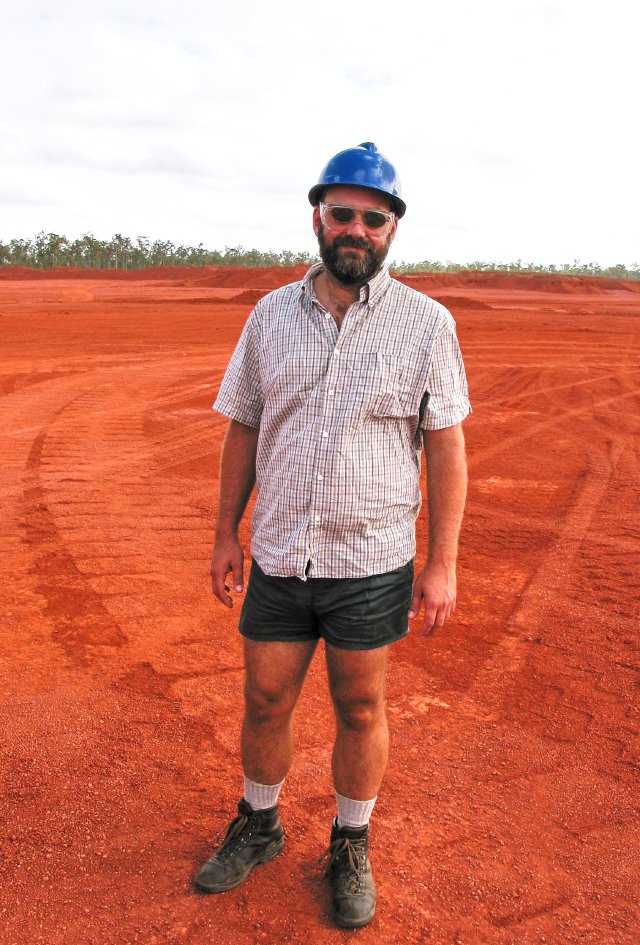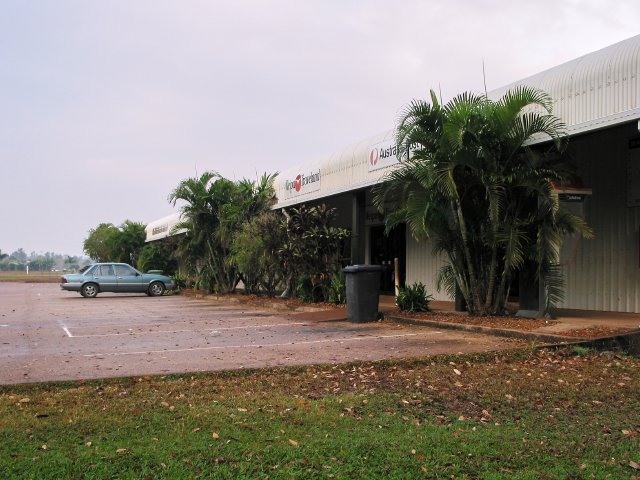Weipa, Queensland
Today we take a guided tour of the Comalco bauxite mine, then head over to the very new Western Cape Cultural Center in the afternoon. Oh, yeah, and we did laundry too.
At 9:00 in the morning, we boarded the big bus at the campground and proceeded out on our tour of Weipa and the Comalco mine. First, we went around town, looking at the various buildings. Comalco set up the town in the mid 1960's, and it has a very spread out feeling that company towns do--in fact, it strongly reminds me of the layout of your typical US Air Force base, with curving streets and everything requiring five minutes drive. Why the planners felt that they needed to separate all the components of a town--residential, commercial, industrial, business--is beyond me. It would've been much easier had they just made a big town square and a grid of streets, instead of roads curving through the wilderness connecting the various suburbs. Weipa--population of maybe 3000--has a good five or six suburbs!
Anyway, though Weipa is spread out, it's also fairly pleasant with lawns and trees along. The houses are designed so they face northwest-southeast, to catch the prevailing breezes, and most are naturally ventilated, with no air conditioning. They have large awnings and coverings to deflect the sun as well. And, this being cyclone country, they all have very low or flat roofs and are designed to survive intense winds. Curiously, though, most are not built on stilts like many homes in Queensland, but are rather build on slabs.
After our tour, we headed out to the active Comalco mine. Comalco has two major areas, one is in east Weipa, the second is north and called Andoom. The difference is the bauxite grade. East Weipa is a higher grade, Andoom is a lower grade. Comalco switches back and forth between the two as necessary based on the price of caustic soda, used to remove the silica impurities from the bauxite. If the price is low, they can afford to buy a lot of it, so they use the Andoom mine face. That's where we went today. Incidentally, soda is a byproduct of the plastics industry, which itself could be considered a byproduct of the oil industry. So in a very round about manner, the price of a barrel of oil affects which bauxite is more productive to mine.
The bauxite around Weipa forms a subsurface layer, one to five meters thick, and the mining isn't too difficult. You simply knock over the trees at the end of the Wet season, burn them, scrape the soil off, and then scrape the bauxite out. Underneath the loose soft bauxite is hard ironstone, so it's fairly easy to feel where it stops. The bauxite itself is little round pearls to 30mm in diameter, and it's scooped out with a loader, which puts it into a belly loader. Both the loader and the belly loader are huge machines. The belly loader simply takes it to a dump bridge, where it opens its belly and dumps it on a conveyer belt. The conveyer belt loads up a train ore car, the train goes the 10 or 15km to the wharf area in Weipa, where it's refined slightly and stockpiled in huge pyramids. Then, when a particular ore ship comes, it's loaded with its appropriate grade of ore, and off it goes. Since various parts of the mine face have different ore grades, the miners are directed to work in various parts according to customer needs.
In other words, it's scrape, load, and ship. It's one of the simplest mining operations. Last year they went through 700 hectares of land, or about 7 square kilometers. They never stop working, either, the mining is continuous, with an eight-day work week: two day shifts of 12 hours, two night shifts of 12 hours, then four days off.
I was impressed, though, that they revegetate all that land. Once they're finished, they put back the topsoil and subsoil (kept in separate piles), then spread it around. Comalco pays local Aboriginal groups to collect plant seed, which they spread on the ground at the beginning of the wet. We passed several regenerating stands, some were very recent and scrubby, some were ten years old and appear to be doing quite well to my admittedly untrained eye. They also don't clearcut the countryside, either, but leave many large stands of original growth woodlands to serve as species refuges and wildlife corridors. Comalco does seem to be minimizing the tremendous impact they're having.
After leaving the mine, we drove back into town, and paused briefly at the sorting facility, where the ore is washed and dried and separated by grade. Some of the bigger bits that are sieved out are used for road grade fill, others are used by the various alumina refineries in Australia and Japan, and one curious product of the ore is called 'calcination' and is used to make the carborundum and aluminum oxide used for sandpaper grit. And, according to our tour guide, 99% of all sandpaper grit worldwide is Weipa bauxite!
The tour finished up with a little bit about the future of Weipa. Comalco's outsourcing many things it once did internally, like electrical and plumbing and carpenters and such, and it's not so interested in running the company town anymore, either. So there's a bit of a sense of change in the air that this town may become 'official' and not a Comalco operation. Comalco is also starting to sell residential lots as well.
With the tour done, we had some lunch, then drove over to the Western Cape Cultural Center, which opened three weeks ago. It was in a neat building, and very well done, explaining both the Aboriginal and European histories of the area, as well as the ecology and natural areas of Weipa and surrounds, with some personal stories also transcribed. That's one of the many things that Australia does well: museums. This was no exception! We were sad to see, though, that though the center had been opened only three weeks, we weren't the first Americans to sign the visitor's book. Some other Californians had beaten us to it!
And then... we did laundry. Later we drove over to the newsagents because we wanted some air conditioning (it's a five minute walk), and because we had figured out that newspapers here are available only after the daily plane arrives from Cairns, usually sometime around 3pm. So we waited for our laundry to dry, and read the paper, drove to the Snack Shack for a burger, and slept.
Weird Wildlife Sighting
Easy! My first cane toad! This one shocked Sue and Heidi as they walked back to their tents at 9pm. They can sure do synchronized screaming! It's kinda average looking, though. Not at all shocking. I expected something more, well, dramatic.







